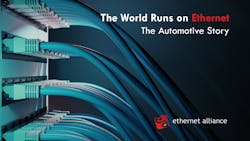Ethernet has expanded to more and more application spaces over its 50 years on the scene, and automotive is one of the technology’s latest and most remarkable success stories.
There is no shortage of market research to illustrate the triumph of automotive Ethernet. "Aided by the increasing adoption of advanced automotive technologies and the growing demand for connected vehicles, the market is projected to further grow at a CAGR of 23.0% between 2023 and 2028 to reach a value of USD 6346.86 million by 2028," reads a May 4, 2023, press release announcing a ResearchAndMarkets.com analysis, Global Automotive Ethernet Market Report and Forecast 2023-2028.
"Automotive Ethernet helps to reduce the complexity and weight of wiring harnesses in vehicles while providing higher bandwidth and more reliable data transmission compared to traditional automotive communication protocols," the ResearchAndMarkets.com release continues. "The growth of the global automotive Ethernet market is primarily driven by the increasing adoption of advanced automotive technologies, such as ADAS (advanced driver-assistance systems), vehicle-to-everything (V2X) communication, and connected car services. These technologies require high-speed, reliable, and secure data transmission, which is provided by automotive Ethernet."
The IEEE 802.3 Ethernet Working Group’s dedicated efforts in the space began in 2012. Most of the world’s automakers weren’t exactly onboard at that point, and it was understandable. Mainstream computer networking engineers were not prevalent at car companies, and Ethernet was a largely invisible technology in an industry with long-established companies, huge bases of deployed products and global workforces, a history of slow and measured adoption of new technologies, and a deeply ingrained legacy of processes and patterns.
In the more than 10 years since those initial forays, however, automotive and Ethernet have forged a successful marriage from every perspective. The automotive industry’s vast, global cast of vendors, original equipment manufacturers (OEMs), Tier X suppliers, system integrators, and providers of systems and components (e.g., sensors, actuators, test and measurement equipment, harnesses and harness components, software, silicon, and control units) for automotive applications have come to embrace Ethernet as a clear enabler of their future. The drivers are varied—no need for gateways and protocol conversions for converging communications across different domains of the car, no translations for connecting with other industries, optimized weight and cost of wiring, high bandwidth and low latency, access to the world’s best experts in cybersecurity, etc. All roads lead to Ethernet.
Along the way, the industry has pursued an unusually sharp learning curve. Today—with the move toward the software-defined vehicle (SDV) and its future-proofing promise of enabling drivers themselves to fluidly and flexibly add features and services—software and Ethernet networking hires dominate automotive engineering growth.
Where are we now? Where to next?
Cooperation across the divide demanded new thinking on the Ethernet side, too, as there had been some reluctance to do application-specific standards development within the IEEE 802.3 community. Furthermore, the automotive industry presented more exacting requirements around electromagnetic interference (EMI) and performance in harsh environments than Ethernet typically had to meet for the offices, data centers, communications infrastructure sites, and homes where it was prominently deployed.
But rollout of open standards and standards-based products has been steady, expanding capabilities and opening new horizons for automotive Ethernet:
- IEEE 802.3bw was approved in 2015, defining 100BASE-T1 for transmitting a data rate of 100 Mbps over unshielded cabling.
- IEEE 802.3bp was approved in 2016, defining 1000BASE-T1 for 1 Gbps technology.
- IEEE 802.3cg was approved in 2019, defining 10BASE-T1S for single-pair Ethernet transmission of rates up to 10 Mbps on a multi-drop network.
- IEEE 802.3ch was approved in 2020, defining 2.5/5/10 GBASE-T1 for 2.5-, 5- and 10-Gbps operation on a single balanced pair of conductors.
- IEEE P802.3cz was approved in 2023, defining 2.5, 5, 10, 25 and 50 Gbps using graded-index glass optical fiber.
Standards innovation continues within the IEEE 802.3 Ethernet Working Group:
- With the transition from legacy electronic, domain-based architectures to zonal architectures to support fully autonomous operation, vehicles will require data rates greater than 10 Gbps. IEEE P802.3cy is a standards-development project near approval that is intended to address the gap by defining 25-Gbps operation.
- Optical fiber is increasingly used in automotive applications, both for Ethernet and other protocols, due to its intrinsic advantages such as galvanic isolation, superior electromagnetic compatibility (EMC) performance, and weight. IEEE P802.3dh is being written to define multi-gigabit optical Ethernet using graded-index plastic optical fiber.
Tracking progress
Along with automation, enterprises, service providers, and cloud providers, automotive is one of the application spaces detailed in the Ethernet Alliance’s Ethernet Roadmap—a publicly available, regularly updated guide to key underlying technologies, current and future interfaces, and diverse application spaces. It’s a unique resource in the industry that is produced by the Ethernet Alliance, a global, non-profit, industry consortium functioning as the voice of Ethernet and the bridge between the technology’s standards and its end-users.
“We are now at the half-century mark and Ethernet’s star continues to rise," said Peter Jones, Ethernet Alliance chair. "As a profoundly resilient technology that’s getting progressively faster, it is an innovation engine that drives market diversification and fuels business growth.”
Nowhere across the technology’s application scope is that more true than automotive. System and component vendors, industry experts, and university and government professionals engaged in automotive globally are encouraged to contribute to future iterations of the Ethernet Roadmap. Please visit the Ethernet Alliance to engage.
Steven B. Carlson is a consulting member of the Ethernet Alliance and currently serves as the chair of the IEEE 802.3cy Greater than 10 Gb/s Automotive Electrical Ethernet PHYs Task Force and is the executive secretary of the IEEE 802.3 Ethernet Working Group. Carlson is president of High Speed Design Inc., a Portland, OR-based consulting company.
Kishore Racherla is a board member of the Ethernet Alliance. With more than 18 years of experience in the semiconductor industry, he is a product manager at Broadcom, managing Ethernet PHY portfolio for automotive as well other markets such as enterprise/industrial applications.
